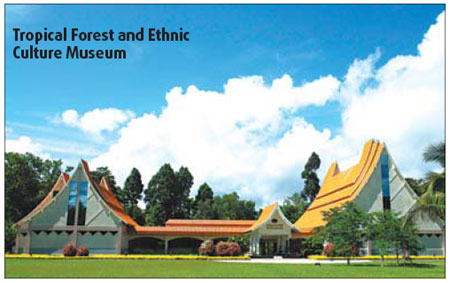
|
REGIONAL> News
 |
|
Flourishing array of botanical wonder
By Li Yingqing (China Daily)
Updated: 2009-07-09 07:43
 Xishuangbanna Tropical Botanical Garden (XTBG), ringed on three sides by the Luosuo River, a branch of the Lancang - or Mekong River - was founded by leading botanist Cai Xitao five decades ago and has since evolved into a comprehensive research, popular science, tourism and conservation center. As the nation's largest botanical garden, it covers 900 hectares and has nearly 12,000 species of plants, some of which have been introduced from other parts of the world. Since its founding, XTBG scientists have completed some 900 research projects, 3,000 academic papers and published more than 30 books. It has been selected as national-level scientific education center, a national AAAA tourism scenic area and a national cultural tourism model. The garden has a range of facilities including hotels, meeting rooms, academic halls, swimming pools, telecommunications networks and tourist markets. Hundreds of thousands of tourists visit the garden every year, and it also attracts many domestic and foreign state leaders and scholars. Xishuangbanna has 44 of the 100 species of fig trees that grow across China, with 1.3 hectares devoted to their cultivation.
It is also home to an "ethnic forest culture garden" that covers more than 3.3 hectares with a museum at its center. Zones in the sub-garden include those for ethnic medicines, edible plants, religious plants and plants famed in literature or other forms of culture. In the prevailing Dai culture in that area of Yunnan, young couples often express love at native mulberry trees while singing songs. XTBG's palm tree garden has the richest species of palms in the nation. Begun in 1976 and covering 93.3 hectares, it has 458 palm species and is now a top research center and seed bank for the family. With bridges, islands, wetlands, it is renowned among both researchers and visitors. Another attraction is an exotic plant garden begun in 1999 when Kunming hosted the World Horticultural Exposition that covers almost a hectare with 243 species of valuable exotic plants. Remarkable plants The botanical garden also grows so-called miracle fruit only 2 cm long that turns from sweet from sour in just two hours after it is picked that is used as a treatment for diabetes. Another natural marvel is the Ficus Benejamina Linn., a tree known as the "killer of tropical forest" for its parasitic life on other trees. Growing as tall as 20 m with a trunk 30-50 cm in diameter, it gradually closes the nutritional sources of host trees. Yet another exotic bit of flora in the garden is the antiaris toxicaria - or breadfruit - tree, the most poisonous on earth. While its fruit is edible, its sap is deadly and used by some cultures to make poison darts. (China Daily 07/09/2009 page7) |